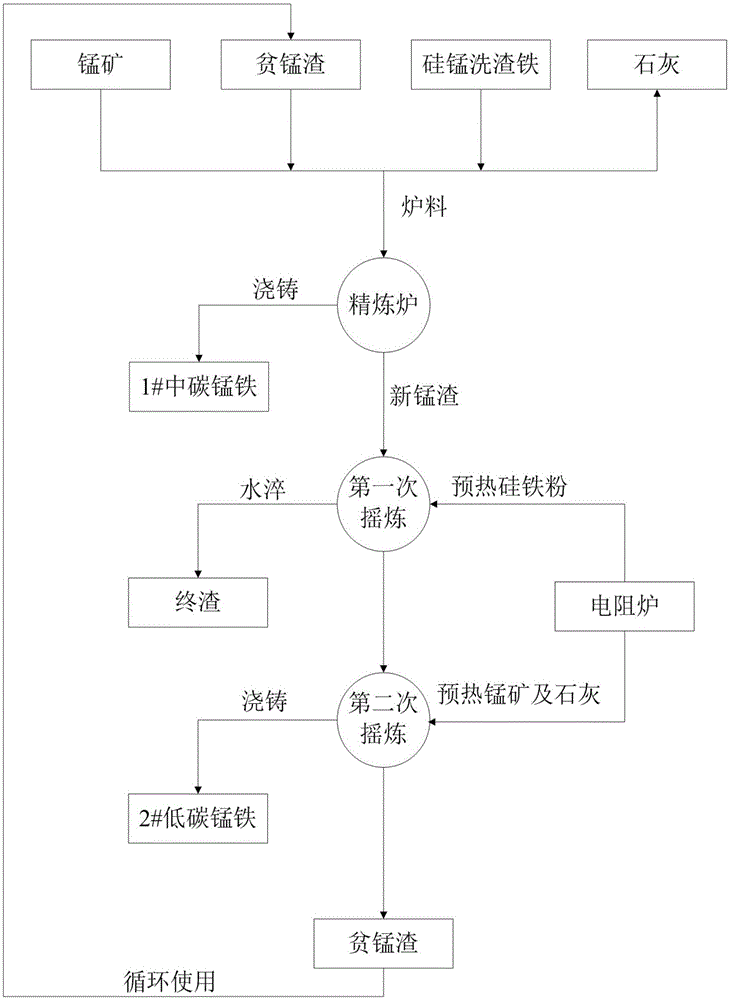Method for refining low-carbon ferromanganese alloy through poor-manganese slag
A low-carbon ferromanganese and medium-carbon ferromanganese technology, applied in the field of alloy smelting, can solve the problems of low silicon utilization rate, single product, high energy consumption, etc., and achieve the effects of reducing production costs, improving production efficiency, and changing process flow
- Summary
- Abstract
- Description
- Claims
- Application Information
AI Technical Summary
Problems solved by technology
Method used
Image
Examples
Embodiment 1
[0054] Such as figure 1 As shown, the present invention provides a kind of method that uses manganese-poor slag to refine low-carbon ferromanganese alloy, comprises the steps:
[0055] (1) Preparation of medium-carbon ferromanganese and new manganese slag: 31.2 parts of silico-manganese slag-washed iron are joined with 20.8 parts of manganese ore, 7.2 parts of manganese-poor slag, and 20.8 parts of lime as charge in the refining furnace, The manganese ore in the furnace charge is decomposed and reduced under the high temperature condition of gradually raising the temperature from 527°C to 1172°C. The maximum refining temperature is controlled at 1500°C. When it is obviously granular, the silicon is judged to be released from the furnace, and the primary smelted product is obtained, and the primary smelted product is divided into 0.2m 3 The flow rate of / min is poured into the ladle for precipitation and separation. The heavier liquid medium-carbon ferromanganese is retained i...
Embodiment 2
[0060] A method for refining low-carbon ferromanganese alloys using manganese-poor slag, comprising the steps of:
[0061] (1) Preparation of medium-carbon ferromanganese and new manganese slag: 39 parts of silico-manganese slag-washed iron are joined with 26 parts of manganese ore, 9 parts of manganese-poor slag, and 26 parts of lime as charge in the refining furnace. The manganese ore in the furnace charge is decomposed and reduced under the high temperature condition of gradually raising the temperature from 527°C to 1172°C. The maximum refining temperature is controlled at 1500°C. When it is obviously granular, the silicon is judged to be released from the furnace, and the primary smelted product is obtained, and the primary smelted product is divided into 0.2m 3 The flow rate of / min is poured into the ladle for precipitation and separation. The heavier liquid medium-carbon ferromanganese is retained in the ladle for casting to produce medium-carbon ferromanganese. The li...
Embodiment 3
[0066] A method for refining low-carbon ferromanganese alloys using manganese-poor slag, comprising the steps of:
[0067] (1) Preparation of medium-carbon ferromanganese and new manganese slag: add 46.8 parts of silicomanganese slag-washing iron to 31.2 parts of manganese ore, 10.8 parts of manganese-poor slag, and 31.2 parts of lime as charge in the refining furnace, The manganese ore in the furnace charge is decomposed and reduced under the high temperature condition of gradually raising the temperature from 527°C to 1172°C. The maximum refining temperature is controlled at 1500°C. When it is obviously granular, the silicon is judged to be released from the furnace, and the primary smelted product is obtained, and the primary smelted product is divided into 0.2m 3 The flow rate of / min is poured into the ladle for precipitation and separation. The heavier liquid medium-carbon ferromanganese is retained in the ladle for casting to produce medium-carbon ferromanganese. The li...
PUM
 Login to View More
Login to View More Abstract
Description
Claims
Application Information
 Login to View More
Login to View More - R&D
- Intellectual Property
- Life Sciences
- Materials
- Tech Scout
- Unparalleled Data Quality
- Higher Quality Content
- 60% Fewer Hallucinations
Browse by: Latest US Patents, China's latest patents, Technical Efficacy Thesaurus, Application Domain, Technology Topic, Popular Technical Reports.
© 2025 PatSnap. All rights reserved.Legal|Privacy policy|Modern Slavery Act Transparency Statement|Sitemap|About US| Contact US: help@patsnap.com


